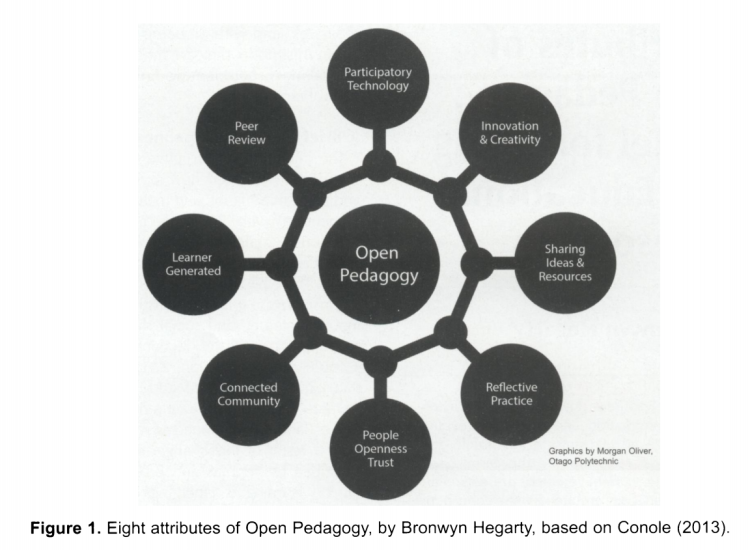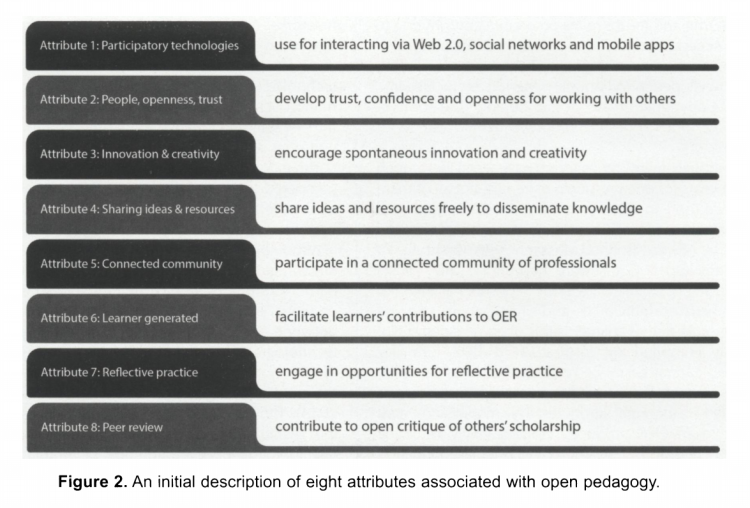In the beginning of the course, we have already discovered the difference between synchronous and asynchronous communication. Now we are going to discover another communication model, open. As Claire mentioned in her post, Dr. Valerie Irvine defined that “In this model the open tier of access is for learners who can participate but are not formally registered to receive course credit for their work”. My first reflection of this definition is that this could be very popular in universities. Because I’m in economics major, so there are many lecture courses (in size of 50 students or larger) which I could take part in without registration. However, after deeper discover and understanding, I found that the open model is way more than what I was thinking.
Firstly, I get to know the “Open Pedagogy”, which is a term that I’ve never heard before. As Claire summarized in her post “when instructors and teachers use openly licensed materials, or they empower learners to develop and create openly licensed materials, often with an end goal of promoting social justice for marginalized people, improving access across diverse communities and equal access to education, they might be considered to be engaging in open pedagogy (Hegarty, 2015; Lambert, 2019)”. After I read the article by Bronwyn, I found that Open Pedagogy can be separated in 8 attributes (as Figure 1 below):

Bronwyn also gives the initial description of these eight attributes associated with Open Pedagogy (as Figure 2 below):

Secondly, it is also very important for this Open model to have a platform. This kind of platform must be a public platform which could be access by everyone. As Wiley’s description, “If the platform is not open, or prevents end users from freely accessing it, through pay walls or other measures, then it is not truly open”. In today’s world, internet could play the role as an open platform properly. Claire gives us a good example of open platform: Wikipedia, which is free to access and can be accessed by everyone. The platform is the most important foundation for running such an open model; otherwise, all of our ideas and works are idle dreams.
Lastly, Open policies could bring the Open model out of the internet. With those policies, this model could come into our daily university life, and give us some materially help. As Claire mentioned in her post, “Kwantlen Polytechnic University has developed a set of policies that encourage faculty to use and produce open textbooks and other materials in their courses and programs. KPU (as of this writing) has identified six full credentials students may complete with zero textbook costs. They call these programs Z-Cred (pronounced ‘zed-cred’ because we are in Canada!) indicating that there are zero required textbook costs”. Textbook always comes with a really high cost, and it is also very formalist. With these Open policies, we may have some ways to get rid of using traditional textbooks.
Reference:
Carolan, C. (2019). READ: Focus for this Unit. Retrieved from Course Spaces.
Hegarty, B. (2015). Attributes of Open Pedagogy: A Model for Using Open Educational Resources. Educational Technology,55(4), 3-13. Retrieved from http://www.jstor.org.ezproxy.library.uvic.ca/stable/44430383
Irvine, V., Code, J., & Richards, L. (2013). Realigning higher education for the 21st-century learner through multi-access learning. Journal of Online Learning and Teaching, 9(2). Retrieved from http://jolt.merlot.org/vol9no2/irvine_0613.htm
Lambert, S. R. (2018). Changing our (Dis)Course: A Distinctive Social Justice Aligned Definition of Open Education. Journal of Learning for Development – JL4D, 5(3). Retrieved from http://www.jl4d.org/index.php/ejl4d/article/view/290